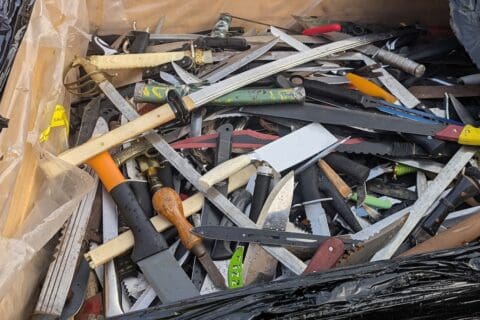A version of this article first appeared in a Special Report on ‘Managing Waste’, published in The Times, 5 March, 2014.

Gold, silver and platinum will be amongst precious metals worth £1.5 billion purchased unwittingly in the UK between now and end 2020. This hoard of hidden treasure will be scattered throughout 10 million tonnes of electronic products bought by organisations, companies and private individuals alike.
Electronic, digital and mobile technologies are big business. The marketplace is competitive, evolving constantly and rapidly. Sales are strong, not least because products date and break.
As a result, product and material recovery, recycling and reuse is also an area of rising concern (and opportunity). Waste Electrical and Electronic Equipment (WEEE) is now the fastest growing waste stream worldwide, with an estimated two million tonnes discarded in the UK every year.
In response, new EU WEEE regulations coming into force this year seek to encourage producers to consider the environment at disposal and end-of-life, designing-out waste and adopting cradle-to-cradle (C2C) responsibility for products.
What will be the effect of these legislative changes? The new obligations carry potential implications for all stakeholders and lifecycle stages, from design, though manufacture, to consumption and finally recovery. How will the market react?
“The majority of rethinking of e-waste is driven by clear and consistent regulatory requirements, primarily emanating from the European Commission”, explains Will Schreiber, co-author of the WRAP report ‘Reducing the environmental and cost impacts of electrical products’ and Associate Director at Best Foot Forward.
“Whether televisions or washing machines, the overall trend in the electrical sector has been to make products less repairable and have shorter lifetimes. The changes that we see in response to legislation, however, are starting to have an effect on the business models some companies are developing by reducing hazardous substances, offering longer warranty periods, or providing buy-back options.”
This emerging trend will ask questions of product designers, a community relatively slow to respond to the waste issue creeping up the corporate and regulatory agenda, according to designer and Head of Sustainability at Seymourpowell, Chris Sherwin:
“I don’t think designers have considered the waste and disposal stages of products anywhere near as much as they should. Most of what we do in design processes is to become the champion of the consumer experience. The main problem with that is it misses off the front- and especially the back-end aspects. We need a broader, more holistic approach.”
He suggests that the conditions for change are gradually becoming manifest in electronics markets, with a combination of contributory factors in evidence:
“It is no secret that carbon/energy has been the main driver for the electronics sector, but companies are turning more to waste and resource consumption, driven by concepts like C2C, the circular economy, rising materials costs, better recycling and recovery infrastructure. It seems more of a priority in design now.”
Momentum in waste markets still seems more push than pull though, as Will Schreiber describes the dynamic:
“Unlike energy consumption, which has direct consumer benefits and therefore demand, material control and optimisation is mostly driven by cost savings and regulations (for critical raw materials such as rare earths, Dodd-Frank conflict minerals). The biggest proponents of change have been the brands themselves setting a clear strategy. The problem is that few organisations have actually looked at waste as a business opportunity rather than a burden.”
This limited response may well be explained in part by the weak signals being received in general from a customer base typically still stuck in consumer mode, as Dr Adam Read, Practice Director – Waste Management & Resource Efficiency, Ricardo-AEA, explains:
“Unfortunately, the drive of consumerism is a little like the Titanic: difficult to slow, almost impossible to divert, and ultimately destined for failure. Although consumers may not be changing on their own, with strong Government leadership, responsible manufacturers and increasing public awareness that recycling is good, but waste prevention better, we can expect to see a shift in direction in the next decade or so.”
Are we nearing a tipping point? Sophie Thomas, co-director of design at the RSA and one of the founders of the Great Recovery Project (reimagining products and material flow cycles) seems to think so. She counsels though that things could yet go one of two ways, with the waste sector “either on the cusp of something great or the edge of cliff”.
Breaking traditional take-make-waste paradigms, depends on a clear business case emerging supply-side and a circle more material than virtuous, Dr Read concludes:
“Ultimately, we are facing significant resource risks in the electrical products world, from rare-earth metals in particular, so price will continue to increase as scarcity worsens. This will drive innovation in product design and processing, including more closed-loop solutions where electrical products are never owned, just leased/rented, thus enabling manufacturers to control the supply of increasingly valuable materials.”
For all the virtual community and cloud computing advantages afforded us by the latest electronic and mobile technology, the means to these online ends are still very much grounded in physical commodities and mineral properties.
Paradoxical as it might seem, we are living in a material e-world.
**********************************************************
Design Case Study
Phonebloks: This year’s module
There are now more iPhones sold every day worldwide than babies born and more mobile devices on Earth than people.
Since the first call made on a 23cm-long 1.1kg Motorola in 1973, the accelerating rate of obsoletion means an average cellphone today is kept just 18 months. Despite leasing initiatives, cashback offers, drawers of ‘retired’ kit, plus some reuse and recycling, e-waste mountains in the US alone have been growing at a rate in excess of 10 million mobiles a month.
For innovation and disruptive technology to make a successful start tackling mobile-related resource consumption and waste, it is wrong however to assume size matters, as Phonebloks Founder Dave Hakkens explains:
“To tackle a big problem, you do not necessarily need a big solution. With the emerging technology empire soon to embrace the Internet of Things, even one solution (such as a mobile) to just one part of the bigger electronics problem still represents something of significance and starts the market shift to modular thinking.”
Phonebloks launched last year via viral video and ‘crowdspeaking’ social media, campaigning to demonstrate the mass-market appeal of modular and attract commercial production partners. Billed as ‘a phone worth keeping’, Phonebloks challenges the notion that electronics are not designed to last.
A collaborative open-platform venture, the concept handset comprises detachable blocks – providing such as processor and storage capabilities, or camera and screen functions – all connected through pins on a base. The modular nature allows for easy upgrading of components. This same designed-in interchangeability also facilitates customisation, described by Dave Hakkens as a demand priority identified in market research:
“Talking to a diverse mix of technology users around the world, with different priorities and situations, the first rule of phone design we learned is that there has to be more to a mobile than just battery life and megapixels. For some owners, being able to measure diabetes indicators, or monitor a heartbeat, features much higher up the agenda than camera capability. Any solution that aspires to become universal must cater for the particular – customisation is key.”
It is important for marketability that users can ‘personalise’ purchases with custom features and so invest in a sense of ownership, choosing blocks they want and supporting brands they like.
Coming full circle, Phonebloks has now teamed up with Motorola, raising the prospect that modular might just answer the call for more sustainable mobile technology begun four decades ago.
To view the Special Report in full online, please click here.
Author: Jim McClelland






